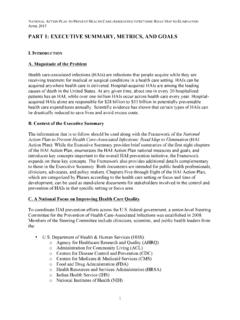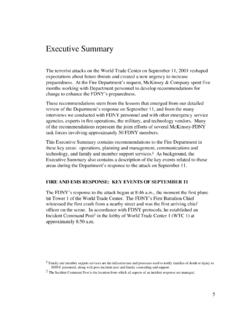Transcription of African American Men and High Blood Pressure Executive …
1 A Review of Psychosocial Factors and Systems-Level Interventions A Closer Look at African American Men and high Blood Pressure Control Executive summary Department of Health and Human Services Centers for Disease Control and Prevention National Center for Chronic Disease Prevention and Health Promotion Suggested Citation: Centers for Disease Control and Prevention. A Closer Look at African American Men and high Blood Pressure Control: A Review of Psychosocial Factors and Systems-Level Interventions. Atlanta: Department of Health and Human Services; 2010. Photos: The photographs used in this publication are for illustration purposes only. They show African American men from various age groups. They are not intended to depict people who have high Blood Pressure or who had a heart attack or stroke. For Free Copies or Additional Information: E-mail: Write: Division for Heart Disease and Stroke Prevention, NCCDPHP. Centers for Disease Control and Prevention 4770 Buford Highway, NE, Mailstop K-47.
2 Atlanta, GA 30341. Phone: 1-800-CDC-INFO (232-4636). TTY: 1-888-232-6348. Online: The findings and conclusions in this document are those of the author(s) and do not necessarily represent the official position of the Centers for Disease Control and Prevention/the Agency for Toxic Substances and Disease Registry. Table of Contents Chapter Page The Burden of high Blood Psychosocial Aspects of Blood Pressure Control among African American Programs With Systems-Level General Health Resources by African American men and Blood Pressure control: a closer look Executive summary 1. Acknowledgments This project was supported by a task order contract (200-2001-00123) between RTI. International and the Division for Heart Disease and Stroke Prevention (DHDSP), National Center for Chronic Disease Prevention and Health Promotion (NCCDPHP), Centers for Disease Control and Prevention (CDC). This document is a continuation of previous work performed by the Program Development and Services Branch in DHDSP.
3 We would like to thank the following people for their participation in making this document a reality: Contributors: Bernadette Ford Lattimore, MPH1; Nancy D. Berkman, PhD2; Andrea Yuen, BS2;. Suzanne M. Randolph, PhD3; Erika Willacy, MPH2; Linda Lux, MPH2; Ben Beatty, MPH2; Shelly Harris, MPH2; Rosanne Farris, PhD1; Belinda Minta, MPH, MBA1;. Adrienne Rooks, BA2; Sheree Marshall Williams, PhD1; Sarah O'Leary, MPH, MA1; Nora Keenan, PhD1; Robert Merritt, MA1; Cathleen Gillespie, MS1; Kathryn Gallagher, MA1; Yuling Hong, MD, MSc, PhD, FAHA1; Michael Schooley, MPH1;. Julie Will, PhD1; Angela Soyemi, BA1 and Darwin Labarthe, MD, MPH, PhD1. 1 Centers for Disease Control and Prevention, 2 RTI International, 3 The MayaTech Corporation We extend many thanks to the project's expert panel for their guidance in the development and content of this guide. Their contributions and participation in the process were key in bringing together the document. The expert panel consisted of: Jean Bonhomme, MD, MPH; Jules Harrell, PhD; B.
4 Waine Kong, PhD, JD; George Mensah, MD, FACP, FACC; Alan Richmond, MSW; and Herman A. Taylor, Jr., MD, MPH, FACC, FAHA. Special thanks to the key informants for providing us with the information necessary to produce this document. They are as follows: Shauntice Allen, MA; Karen Boone, RN, MN, MPH; Jeanne Charleston, RN; Akilah Heggs, MA; Devon Love; James Plumb, MD, MPH; Sara Eve Sarliker, MPH; Berenice Tow, MS; and Ronald Victor, MD. African American men and Blood Pressure control: a closer look Executive summary 2. Recommendations Top 10 Considerations for Public Health Programs When Planning Systems-Level Interventions for African American Men to Control high Blood Pressure Because public health programs share the Division for Heart Disease and Stroke Prevention's mission of eliminating disparities in the burden of heart disease and stroke, this document provides a tool that can be used to develop or fund systems-level interventions, particularly addressing African American men and high Blood Pressure control.
5 Below is a list of considerations as public health programs plan, develop, and implement systems-level interventions for this underserved population: 1. Review and become familiar with the national prevalence data on hypertension in African American men, as well as factors related to awareness, treatment, and control. Gather and analyze state and local data on this population; determine priority groups or localities if appropriate. 2. Become familiar with the psychosocial factors ( , effects of racism, social support, access to care) related to high Blood Pressure control among African American men. 3. Identify and share data with stakeholders that public health programs might partner with when developing interventions related to high Blood Pressure control in African American men. 4. Collaborate with nontraditional partners ( , faith-based organizations, sororities and fraternities, barbershops) to develop and implement interventions for this population.
6 5. Before implementing an intervention, examine the history and politics of the community. Be sure to include members of the community during the initial planning stages of an intervention or activity. Not only does this build trust, but it can also increase the chances that the intervention or activity will be successful. 6. Identify settings or mechanisms for possible intervention, which may include conducting community needs assessments or environmental scans of potential sites and how the priority group could best be reached. 7. Identify reviewed projects and interventions that have been evaluated for possible pilot programs; determine characteristics of programs that are most compatible with potential pilot program setting. 8. Consider reviewing information on similar interventions and programs dealing with men's health concerns to discover promising or best practices regardless of topic area, such as prostate cancer or diabetes. 9. Review the Lessons Learned from interviewed programs and Key Findings from literature reviews to use as tools to develop interventions or similar activities for your target population.
7 10. Develop evaluation plans for proposed interventions. African American men and Blood Pressure control: a closer look Executive summary 3. Introduction 1. Heart disease and stroke impact the population in epidemic proportions. According to the American Heart Association, these conditions have led to direct and indirect costs of an estimated $475 billion in 2009. With heart disease and stroke being the first and third leading causes of death and major causes of disability, national and international experts agree that now is the time to take action in addressing these conditions and their risk factors. Disease burden and growing disparities among certain populations are characteristics of the heart disease and stroke epidemic. One of the populations greatly affected by this epidemic is African American men. African American men suffer disproportionately from high Blood Pressure , a known risk factor for heart disease and stroke. Because of this, the Centers for Disease Control and Prevention's Division for Heart Disease and Stroke Prevention (DHDSP) began to focus attention and resources to developing materials that provide answers.
8 DHDSP contracted with RTI International, with assistance from the MayaTech Corporation, to create a document addressing high Blood Pressure control in African American men. The purpose of the book is to highlight resources and systems-level interventions regarding high Blood Pressure control of African American men to stakeholders (such as state and local government agencies, health care organizations, non-profit organizations, and others) to facilitate positive changes in their states and communities. A systems-level intervention is defined as a change in policy, legislation, training, or environmental supports that impacts individual and community-level outcomes. Systems-level interventions can focus on organizations, providers, patients, and the health care system as a whole, and can also include media campaigns. Information for the review was gathered through input from an expert panel, key informant interviews with individuals conducting interventions, and a search of the literature.
9 This Executive summary (abridged version) of the book was created to use as a quick reference guide. It contains an overview and summaries of the more in-depth information and findings presented in the unabridged version including: A list of recommendations to guide state programs as they create systems-level interventions to serve African American men;. Key statistics on burden data pertaining to African American men and high Blood Pressure ;. A summary of psychosocial factors that have been found to be related to disproportionately high Blood Pressure rates among African American men;. An overview of effective and culturally appropriate promising practices and interventions;. A list of men's health informational resources. African American men and Blood Pressure control: a closer look Executive summary 4. The Burden of high Blood Pressure 2. Overview In this chapter, we summarize the burden of high Blood Pressure in African American men and include comparisons with other groups.
10 According to the Seventh Report of the Joint National Committee on Prevention, Detection, Evaluation, and Treatment of high Blood Pressure (JNC VII report), the classification for hypertension, or high Blood Pressure , measures greater than or equal to 140 mm Hg systolic or greater than or equal to 90 mm Hg We include statistics at the national level on morbidity and mortality related to hypertension and the associated conditions of heart disease and stroke. Morbidity Elevated Blood Pressure Table 1 reports the percentage of African American , white, and Mexican American men and African American women with elevated Blood Pressure . Elevated Blood Pressure is defined as having systolic Pressure of at least 140 mm Hg or diastolic Pressure of at least 90 mm Hg. The data are collapsed into three time spans on the basis of data availability: 1988 1994, 1999 2002, and 2003 2006. In all periods, a larger percentage of African American men had elevated Blood Pressure than did white or Mexican American men.















